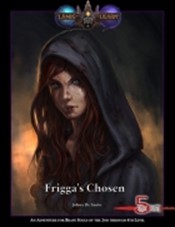 Frigga’s Chosen is an adventure by Johua De Santo for 2nd-4th level characters. It’s presented as a 23-page pdf, nicely illustrated. My major problem with the production comes from the computer-generated maps: they look great, but the grid pattern is nearly invisible, making it very hard to judge their scale. Indeed, the scale of the maps is very interesting: if the grid is 5 feet per square, then we have some truly huge rooms here. For instance, a dining hall in a waystation is 50 feet by 40 feet – holding a table and six chairs. In general, I prefer having bigger rooms than “real life”, simply because of how D&D handles miniatures, but the scale seems slightly odd in this case.
Frigga’s Chosen is an adventure by Johua De Santo for 2nd-4th level characters. It’s presented as a 23-page pdf, nicely illustrated. My major problem with the production comes from the computer-generated maps: they look great, but the grid pattern is nearly invisible, making it very hard to judge their scale. Indeed, the scale of the maps is very interesting: if the grid is 5 feet per square, then we have some truly huge rooms here. For instance, a dining hall in a waystation is 50 feet by 40 feet – holding a table and six chairs. In general, I prefer having bigger rooms than “real life”, simply because of how D&D handles miniatures, but the scale seems slightly odd in this case.
The adventure begins with the party accompanying a merchant caravan through the mountains. The way station they come to has been attacked by undead, and the group need to enter the caves beneath to make the place safe for the caravan to stay the night.
There is some very odd design in this section of the adventure. The entrance to the caverns – a trapdoor in the way station – is covered by a rug of smothering, which seems an odd adornment in a place that many travellers will use. There are also a very large number of monsters in the caverns below. It’s particularly odd to see the map have areas 5 and 7 basically as extension of each other, but treated as different areas with different monsters in each!
The undead are led by a vampire who has been searching for a small black box hidden beneath the waystation. Obviously, this is an important box that the players must guard with their lives!
Unfortunately, that’s not how the adventure assumes it will go. Instead, the box must be left behind – either with the remaining guards, or given to the merchants the players are escorting. It’s terribly clunky and it railroads the players.
The reason the box needs to be given to someone incompetent to guard is revealed in the second half of the adventure, where the adventurers meet up with a priestess of Frigga (the titular “Frigga’s Chosen”) and have to stop a wight from detonating a bomb for which the box is the key. (The players are going to be unsuccessful in stopping the wight, but Frigga will step in to see that the world doesn’t get destroyed). This section also involves a lot of monsters, once again in very close proximity to each other.
The adventure proper takes up about nine pages; the remainder of the document contains adventure background, stat blocks, a few new magic items, plus a “sub-class”, the Chosen. This sub-class has numerous rules issues; of most concern to me is the granting of an additional spell slot of each level to a cleric, in addition to other bonuses. Balanced, this is not.
There are good ideas in this adventure, in particular the inclusion of some references to the real world, but overall the adventure disappoints. Structurally, it’s a mess: it lacks a proper introduction, makes a lot of assumptions about party behaviour without explaining what needs to happen, and the dungeons are badly designed. The adventure is not without ambition, but it is tremendously flawed.

I thought the first part was a bit oddly constructed. In addition to the carpet, it felt entirely too probable the party could entirely miss the entrance to the caverns and miss most of the adventure. Additionally, the monsters in the caverns felt *far* too difficult for a typical part of level 2-4 characters. How on earth would an average party of that level have any hope of defeating a vampire? Sure, if they were specifically hunting vampires and were decked out with stakes, holy water, and the like they might have a chance, but that isn’t the set up. And then add on its not in substantial guardians and you’ve got a fight that would challenge a party of characters twice that level.
I thought the second half held together much better. The priestess of Frigga was nicely drawn out, it felt atmospheric, and the challenges felt far more appropriate.
I think some of the tidbits it includes about… oh, lets call it “world building” are things DMs are likely to have diverse feelings about, but its an interesting idea and easy enough to include or exclude. One bit I probably will use is that the campaign I’m running will eventually have the followers of Orcus as major recurring bad guys. If you change one letter in one character’s name in some of the ancient lore passed onto the characters, you suddenly have a very interesting origin story for the erstwhile demon lord.